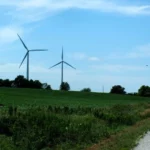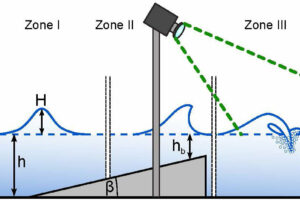In four terms as a county elected official in northern Ohio, it was the most contentious issue Doug Weisenauer had ever seen.
The state legislature had newly empowered county governments to drastically restrict wind and solar power development, a process formerly overseen by the Ohio Power Siting Board, and the meetings of the three-member governing body for Crawford County (population 41,754) suddenly started becoming a lot more animated.
“As soon as Senate Bill 52 passed, the anti-wind people, they started converging on our weekly commissioners’ meetings and demanding that we do something,” said Weisenauer, a Republican, like the other two members of Crawford County Commission.
Apex Clean Energy, a Virginia company, had been signing leases with locals for a proposed 300-megawatt wind farm, called Honey Creek, but Weisenauer was skeptical it would ever get built, saying in an interview he’d seen more than half a dozen would-be wind projects come and go.
Ultimately, the commissioners voted 2-1 last year, with Weisenauer the lone no vote, for a 10-year ban on wind development. The commission’s decision was overwhelmingly upheld by county voters in a referendum last fall.
“I said all along I am not telling people what they can and can’t do on their property,” Weisenauer said. “It got ugly. Our families have been split, friendships broken. It was bad for our community.”
Crawford County, of course, is far from an isolated case. Across the country — from suburban Virginia, rural Michigan, southern Tennessee and the sugar cane fields of Louisiana to the coasts of Maine and New Jersey and the deserts of Nevada — new renewable energy development has drawn heated opposition that has birthed, in many cases, bans, moratoriums and other restrictions.
With states, corporations, utilities and the federal government setting aggressive renewable energy goals, as well as big tax incentives such as in last year’s Inflation Reduction Act, wind and solar developers have been pushing projects that are igniting fierce battles over property rights, loss of farmland, climate change, aesthetics, the merits of renewable power and a host of other concerns.
And those debates are often happening in a miasma of misinformation and skewed by political polarization. However, some who have seen the backlash to renewable development up close and personal also say developers need to do a better job of being upfront with communities and convincing them of the benefits of their projects.
“I’ve seen it getting worse and worse over the past four years. There’s a huge level of distrust,” said Tony Zartman, a former Paulding County, Ohio, elected official who now works for the Conservative Energy Network, which promotes market-based policies at all levels of government to promote a clean energy transition.
‘We’re seeing so much opposition’
In a report updated last year, the Sabin Center for Climate Change Law at Columbia Law School found that “in nearly every state, local governments have enacted policies to block or restrict renewable energy facilities and local opposition has resulted in the delay or cancellation of particular projects.”
Not including what it called “reasonable regulations,” the 2022 edition of the report found 121 local policies (up 17.5% from 2021) that block or restrict renewable energy and 204 contested renewable energy facilities (up 23.6%).
“This report demonstrates that ‘not in my backyard’ and other objections to renewable energy occur throughout the country and can delay or impede project development,” the report says.
Renewable siting debates in Virginia
In Virginia, local debates over renewables have centered on solar. The 2020 Virginia Clean Economy Act, a roadmap for decarbonizing the state’s electric grid by midcentury, calls for the state’s largest electric utilities to put forward plans for the development of over 16 gigawatts of solar and onshore wind energy by 2035. Wind development has centered on offshore plans by Dominion Energy, with only one major onshore project, Apex Clean Energy’s Rocky Forge project in Botetourt County, facing years of local resistance as it moves through the planning process.
Read more:
Virginia’s biggest proposed solar project is also among its most contentious local land use fights
As solar farms multiply across Virginia, officials reckon with land use challenges
One of this year’s biggest solar bills is all about forests and farms
Five takeaways from the landmark Virginia Solar Survey
State work group on solar development achieves little consensus on new regulations
In August, the National Renewable Energy Laboratory released a pair of datasets on local wind and solar energy zoning laws and ordinances. There were nearly 2,000 wind energy ordinances and almost 1,000 for solar energy.
“The significant uncertainty created by difficulties in siting and permitting may make it more difficult for developers to sign contracts with buyers and/or obtain financing at a reasonable cost of capital,” said José Zayas, executive director of policy and programs at the American Council on Renewable Energy, a nonprofit pushing to transition the economy to renewable power.
J.R. Tolbert, vice president of strategy and partnerships at Advanced Energy United, a trade association representing wind and solar developers, as well as energy efficiency, battery storage companies and other businesses, said local opposition is becoming a major obstacle.
“The siting issue in and of itself is an issue that is really important for us to address,” he said. “If we’re unable to site projects, then we’re unable to interconnect projects and we’re unable to deliver that energy.”
Decarbonizing the U.S. electric grid, which accounted for about a quarter of U.S. carbon emissions in 2020, not to mention the rest of the U.S. economy, will require vast new solar, wind and other resources, many experts agree. Doing so by 2035, the Biden administration’s goal, will require “rapid and sustained growth in installations of solar and wind generation capacity” that amounts to “more than four times the current annual deployment levels for each technology,” per another report in August by the National Renewable Energy Laboratory.
“My guess is that we’re going to need a lot of renewables built on public lands further west, just because we’re seeing so much opposition growing up, especially sort of the middle of the country that’s already very dense on wind,” said Rich Powell, CEO of Clear Path, a nonprofit policy group working to curb carbon emissions, during a panel discussion on the state of the electric grid since the deadly 2021 winter storm Uri.
‘Many more peoples’ backyards’
Indiana is emblematic of some of those tensions. The state is simultaneously home to a solar project that’s one of the nation’s largest and lauded by Republican Gov. Eric Holcomb but also, increasingly, county regulations that restrict or outright prohibit wind and solar projects, per the Indianapolis Star.
“We’ve got more than 120 renewable energy projects underway in Indiana,” said Dave Arland, a spokesman for Hoosiers for Renewables. “Some have faced opposition, and some have not. But obviously the trend — from our standpoint — is positive.”
Part of the reason behind the growth in opposition is the nature of wind and solar power itself. Rather than a traditional coal, gas or nuclear power plant that might only be seen by a handful of neighbors, solar developments and wind turbines are more spread out and invite more NIMBY-style complaints.
“Plenty of people don’t have a strong opinion about wind and solar in the abstract,” said Ben Inskeep, program director at the Citizens Action Coalition, an Indiana consumer and environmental advocacy group. “It’s literally in many more peoples’ backyards.”
There’s also an ideological bent to some of the opposition, said Kerwin Olson, the coalition’s executive director, who’s spent years working on energy policy in Indiana. “The direction of discourse really pivoted when we elected President Obama,” he said. “You were a socialist if you supported wind and solar.”
Though Zartman, the Republican former county commissioner from Ohio, acknowledged that some of the loudest pushback comes from conservatives, he said he sees a “mix” of motivation in opponents, including major resistance to changes to the skyline. (Some renewable projects even in famously liberal areas have sparked major opposition.)
“I haven’t seen anywhere on a deed that it tells you you have control over your horizon and your view,” he said.
‘It does have downsides’
Bob Sostakowski, who’s lived in Crawford County, Ohio, for more than two decades and joined the local anti-wind effort after he became aware of proposed projects popping up in his and neighboring communities, said there’s more than aesthetics at stake.
“I had no opinion one way or another on wind until this,” Sostakowski, 48, said. “There’s an obvious and very provable negative impact on property values and people’s standard of living.”
Both Sostakowski and Kimberly Groth, 42, who lives in neighboring Seneca County and was heavily involved in the effort to defeat wind projects there and in Crawford, said it’s not reasonable to expect people in agricultural areas to put up with commercial wind farms.
“People want quality of life and people move to rural areas because of the peacefulness of it. When you introduce industrial-scale wind over tens of thousands of acres, you’re interrupting that quality of life,” Groth said. “I think we’ve heard for 20 to 30 years now about renewable energy and there’s just this assumption that it’s good and that it’s going to save us. So I think for me personally the more I looked into it, the more I realized it does have downsides. … Every form of energy has these pros and cons.”
Sostakowski rejected the notion that farmers and landowners should have the right to lease their property to big wind developers whether or not their neighbors agree.
“There is a big distinction between commercial farming and agriculture and the heavy industrial production of electricity,” he said. “At no point in our history has it been OK for people to do whatever they want.”
Sostakowski added that when he was a kid, a bald eagle sighting was so rare, his parents would pull the family car over to catch a glimpse of one.
Decades later, the fact that a wind project can get a “take permit” for eagles or other protected birds that run into the blades is “unfathomable,” he said, for an intermittent energy generation source that takes up lots of space.
“What a horrendous and irresponsible waste of resources, our manpower, our tax dollars and our wildlife,” he said.
‘It’s no inconvenience’
Matthew Eisenson, a fellow at the Renewable Energy Legal Defense Initiative at Columbia’s Sabin Center for Climate Change Law, said many of the debates over local renewable energy siting take on similar contours.
“In almost every one of these contested projects people talk about visual impacts,” Eisenson said. “Second most common is impact to property values. A lot of people cite impacts to health which are spurious.”
Autism. Livestock harm. Soil and water contamination. Sleep deprivation. Illness. Interference with emergency medical flights. Former President Donald Trump famously (and falsely) said wind turbines cause cancer.
Many of those dire consequences and more crop up in debates about wind and solar siting and populate the Facebook pages and websites that pop up to oppose renewable development.
Whether “Wind Farm Syndrome” really exists or is a psychosomatic condition created by fear of turbines themselves has been debated for years. Numerous studies, including an inquiry funded by the Finnish government on inaudible “infrasound,” have found no evidence turbines cause any health effects.
That’s not to say that there are no impacts from wind and solar. Utility-scale solar takes up a lot of land, requiring anywhere from 5 to 10 acres per megawatt. And there can be big drainage and sediment pollution problems if developers are careless. Wind turbines are huge and visible for miles. They do kill thousands of birds and bats a year, though scientists are trying to make them less deadly. While it’s rare, they can catch fire or leak lubricating fluid. And like any piece of machinery, they can break.
Mike Brady, 69, a farmer from Paulding County, Ohio, has 11 turbines on his 3,000 acres, where he grows corn and soybeans. The first became operational 12 years ago.
“A turbine takes up maybe three-quarters of an acre,” he said. “You just farm right around them. It’s a little inconvenient but for the price you’re getting paid it’s no inconvenience.”
He says there is occasional “shadow flicker” (the effect of the sun shining through the turning turbine blades) and some noise.
“There is flicker at my house. It’ll maybe last five minutes. It just depends on the wind and the angle of the sun. We pull our drapes,” he said. “You’ll hear a noise at like 4 a.m. if you go outside because there’s no other noise. … You can hear a hum out of them. But it doesn’t keep you awake.”
Once, a turbine blade broke, which made “quite a noise,” he said, and birds do get hit occasionally.
“They have done bird studies around a couple of my turbines,” he said. “They find one or two birds a year. Of course they assume that they hit the turbine.”
But both Brady and Zartman, the former Paulding County commissioner, said the turbines have been a windfall for rural Paulding’s local school and government coffers.
“As a county, we were virtually bankrupt,” Zartman said. Paulding, entirely reliant on agriculture and with a population of about 19,000 as of 2021, had been hit hard by the recession that began in 2007. There was some resistance to hosting turbines, which he described as coming from out of state, but it never got much traction, he said.
“The anti group was telling everybody that our large commercial dairy farms would quit producing milk because of the noise and the flicker effect from the turbines. They told us all of our children would be autistic,” he said. “They never really got a firm foothold in our community.”
By 2019, wind development, then at 188 turbines, was pumping about $2.5 million in payments in lieu of taxes into the county budget, a local news outlet reported.
“All the school districts struggled with money. Now they’re doing quite well,” Brady said.
‘It’s our land’
When part of their 300 acres of farmland in rural Seneca County, Ohio, was leased for a potential wind project, Anne Fry, a retired local teacher, and her husband were looking forward to the additional financial security a lease payment would provide, but also the influx of cash the project was expected to bring in for the local school system.
“At first we were excited,” Fry said in an interview. “I was naive about so many things.”
She got a rude awakening at an early meeting on the project.
“I thought, ‘I can’t wait to see if there’s going to be a turbine on our land,’” she said. “It was packed. I saw people, they were so angry they were shaking. They were furious. … They said it was all done in the dark of night, it was secretive. … I didn’t think anybody cared.”
Ultimately, Seneca County commissioners voted in November of 2021 to ban large wind and solar projects in all unincorporated areas of the county.
“It’s our land. And if we want to grow corn, soybeans, or put green energy on our land, why is it someone else’s choice, who might live on a postage stamp-size lot, to tell us what we can and cannot do with our land?” Fry said.
Indeed, hosting renewable development has become an attractive option for struggling farmers.
Per the U.S. Department of Agriculture, the number of U.S farms has fallen from a peak of 6.8 million in 1935 to about 2 million in 2021, down from 2.2 million in 2007.
Farmers have been under financial pressure from the pandemic, a trade war with China (the world’s largest agricultural importer), severe weather events, depressed prices and rising costs of production like fuel, fertilizer, equipment and other inputs, said Andrew Walmsley, senior director of government affairs for the American Farm Bureau Federation, which has 6 million members nationwide.
Against that backdrop, leasing acreage for wind and solar can be a lifeline to financial stability.
“It’s a great predicament to be in if you want to diversify income,” Walmsley said. “It also creates challenges in a lot of rural communities.”
Many farmers lease some or all of the land they farm, and others are looking to buy more ground to take advantage of economies of scale. Siting renewable energy on prime farmland increases the cost of doing that, Walmsley noted.
“When that acreage is lost, that drives up the cost across the community. That’s the biggest rub,” he said.
Dave Crum, 78, who lives in Crawford County and has a lease for what was going to be Apex’s Honey Creek project, said he was also surprised by the degree of resistance, including the landslide vote that upheld the commissioners’ wind ban.
“I can’t understand the difference between renting your land for crop land and renting your land for a wind turbine,” he said. “It’s baffling when you have things that you think will help the community and they don’t let it happen.”
Sitting at his dining room table on a frigid February morning, he compared the resistance to stories his grandfather, a local elected official, told him about people who cut down utility poles during rural electrification.
“I’m not sour grapes. They voted to do that. Make sure you understand what you did,” he said. “Crawford County’s a very conservative place. Sometimes it kicks them in the butt.”
Honey Creek, in addition to payments to hundreds of local landowners and neighbors, would have provided up to $2.7 million per year in new revenue for local schools, county services and township governments in Crawford, about $80 million over the life of the project, according to Apex Clean Energy.
“We were very disappointed in the result of the vote, which embodies a dangerous and precedent-setting expansion of government authority over local property rights,” said Brian O’Shea, a spokesman for the company. “The result restricted and effectively seized the individual land rights of more than 500 Crawford County farmers and landowners, who lost the ability to decide what they wanted to do with their own property.”
In an email, Larry Schmidt, a Crawford commissioner who voted for the wind ban, said “very little dialogue took place between the anti-wind groups and the developers, making it difficult to have a conversation with a differing viewpoint.”
Schmidt said he supported the wind ban to give locals a vote on the project.
“I favored this option because the developer indicated that they would challenge our decision by ballot,” Schmidt said, adding that he “pondered and prayed over this a lot” before making up his mind.
“I do feel we may be missing out on economic gains, however we are more densely populated and the voters have spoken and voted overwhelmingly against,” he said. “And we work for them.”
Selling communities on the merits
Tolbert, the vice president of strategy and partnerships at Advanced Energy United, the trade group, says renewable energy companies need to build a “bigger tent” to help sell communities on the merits of projects.
“We need to make this as an industry about workforce development, putting people to work, delivering money that can come into your community to help pay for schools, fire and EMS and for all the programs communities need,” he said.
Developers also want regulatory certainty, he said, calling for more states to follow Illinois’ lead in setting statewide standards for wind and solar siting, an end run around the type of local opposition that has snarled projects even in deep blue states. It can be politically tough, however, to water down or strip away local land use control, as lawmakers in neighboring Indiana found out when similar legislation setting statewide standards for wind and solar siting failed in 2021. Voluntary standards passed last year. Zayas, with ACORE, pointed to New York, which created an Office of Renewable Energy Siting to consolidate environmental review and permitting of major facilities into a single process.
“The reality is oftentimes what happens is a developer gets into the process, invests hundreds of thousands or millions in the process and a county can at the last moment change the rules on them,” Tolbert said. “That’s a process that isn’t fair.”
However, developers can also do more to build trust in communities. Zartman said.
“They have a community in their target area for quite a while but then they start going out to try to get leases. They really don’t tell anyone openly that this is what they’re thinking until they’ve got quite a bit of the land leased,” he said. “By then they’ve invested oodles of money but they haven’t done anything to try to help public opinion.”
Both Sostakowski and Groth, the Ohio wind opponents, said a lack of advance notice from wind developers helped galvanize opposition.
“By the time the community feeling on this becomes apparent the leases are already signed,” Groth said.
Zartman said renewable companies need to sell communities on the benefits of projects “before you come in and try to steamroll your way” to approval.
“How do you get community support if that’s how you start?” he said. “I understand what they’re thinking but as a former public official it’s a lot easier for me to be on board with a project if I’m part of the original planning process.”
Source: Fauquier











Add Comment